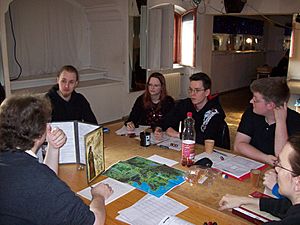Role-playing game facts for kids
A role-playing game (or RPG) is a type of game where you pretend to be a character. You can play RPGs in different ways: by talking and using your imagination (these are called traditional RPGs), by playing on a computer or video game console, or even by yourself using special books called gamebooks. As your character goes on adventures, they often gain experience (EXP). This EXP helps your character become stronger and better at what they do!
Contents
Traditional Role-Playing Games

A traditional role-playing game, also known as a tabletop RPG, is a game where each player imagines they are a character in a made-up world. Players describe what their character does, and a set of rules helps decide if their actions work.
Another player, called the gamemaster (GM), controls the story and the game world. The gamemaster tells the players what's happening, where they are, and acts out all the other characters and monsters they meet. The GM also gives players quests or tasks to complete.
Characters usually have special abilities like strength or speed. When characters finish quests, they earn experience points. These points can be used to make their character even better!
Most tabletop RPGs use dice when a player tries something difficult. This could be attacking a monster or jumping over a big gap. Dice rolls add an element of luck to the game, along with skill. Many games also have ways to give characters bonuses, helping them succeed more often.
Here's a quick example of how a traditional RPG might sound:
GM: "You walk into a small, wet room that smells bad. You hear water dripping. In the middle, you see a small, wobbly pile of gray jelly."
Player: "I carefully touch the jelly with the tip of my sword."
GM: "The jelly starts to slide up your sword!"
Player: "Oh no! I drop my sword right away."
GM: "The jelly starts to eat your sword, but you are safe."
Good gamemasters make the game fun by balancing challenges and rewards. They let players learn from mistakes but also show that actions have consequences. A very famous example of this type of RPG is Dungeons & Dragons.
Computer and Video Game RPGs
Graphical RPGs
Many RPGs are played on computers or video game consoles. In these games, you control one or more characters. A great example is the Final Fantasy series. Just like traditional RPGs, your characters in these games gain EXP and level up. They also usually have a main story quest and many smaller side quests to complete.
Computer RPGs are easy to play because you only need one person. However, they might not offer as much freedom as traditional games, where new quests can be invented anytime.
MMORPGs (which stands for Massively-Multiplayer Online Role-Playing Game) are computer games where many players meet online. They all play together in one huge game world and go on quests as a team. Some popular MMORPGs include World of Warcraft, Everquest, and Runescape.
Text-Based RPGs
Text-based RPGs are quite similar to traditional RPGs. They are often based on games like Dungeons & Dragons. However, some text-based RPGs are not about fighting. Instead, they focus on letting players socialize and meet others online.
For many text-based RPGs, you need a special program called a "client." This program sends what you type to a game server, which might be in another country. Some clients are simple and show text in one color. Others use different colors, which makes the game easier to read and enjoy. You can find more details about these games by looking up MU*.
Live Action Role-Playing Games (LARP)
In a LARP, people play their characters in real life, much like a play. Players act out what their character does, dress up in costumes, and often talk like their character would. It's like stepping into the game world yourself!
Images for kids
See also
 In Spanish: Juego de rol para niños
In Spanish: Juego de rol para niños




